Known as master pollinators, bees are always welcome in every veggie patch, aesthetic garden, agricultural field, and natural area.
There are approximately 20,000 different species of bees in the world, and 4,000 of them are native to the USA.
As it would be nearly impossible to discuss all of the species, let’s take a look at the three most common kinds of bees, most likely to find in and around your garden: The Carpenter bee, Bumblebee, and Honey bee.
These species differ in their physical appearance, nesting habits, pollination attributes, times of the day and year that they are active, their reproductive methods and life cycle, as well as bringing different pros and cons to your garden.
Continue reading to learn more about each of these common bee species, how to identify them, and what benefits they could bring to your environment.
Appearance And Identification Of Carpenter Bees, Bumblebees And Honey Bees
As they all are part of the same family, there are many similarities between the anatomy of these three types of bees. All of the three species are composed of three sections: the head, thorax, and abdomen and they all have six legs, a pair of antennae, and a pair of wings.
To identify the individual species, there are a few things you can look out for.
Identifying A Carpenter Bee
Carpenter bees closely resemble bumblebees. One major difference between the two is that the abdomen of the carpenter bee is bare and slightly shiny.
Carpenter bees are robust in the same way that a bumblebee is, have a yellow, furry thorax, and are mostly black. However, some of the species appear in green or purple color.
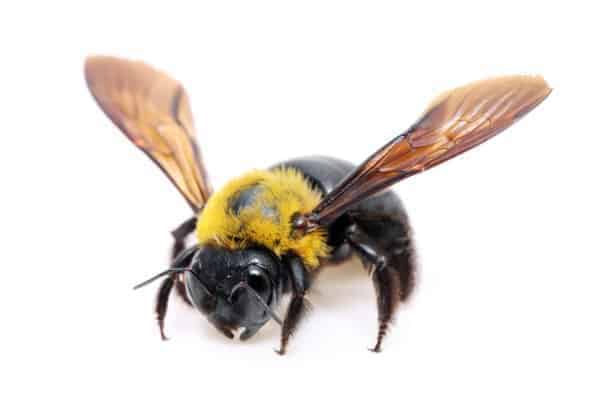
Male carpenter bees have a yellow head with a white dot, while females heads are black.
Another interesting identification between male and female carpenter bees, although difficult to spot, is that only the female carpenter bee has a stinger.
Carpenter bees typically grow between 1/2 and 1 inch in size, and there is a clear distinction between their head thorax and abdomen.
We actually have a comprehensive article on identifying carpenter bees. If you want to know more the article is called, Black Bees, You Need To Know The Good From The Bad
Identifying A Bumblebee
Roughly the same size as a carpenter bee, bumblebees grow between 1/4 and 1 inch, and they are also big and robust.
Bumblebees are furry throughout their bodies and have fuzzy yellow and black bands. Therefore it can be tricky to distinguish the different body parts of the bee.
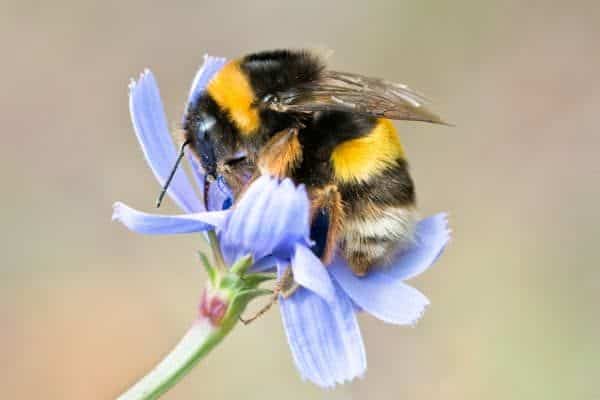
The best way to distinguish between a bumblebee and a carpenter bee is to look at the color of the abdomen. If it is black and shiny, it is a carpenter, while if it is fury and banded then it is a bumblebee.
Identifying A Honey Bee
Honey bees are significantly smaller than both carpenter bees and bumblebees. On average a honey bee is approximately 1/2 inch in size, although this varies between the drones, workers, and queen bees. Honey bees have a more slender appearance and their abdomens ends at a point.
Other than the size, a good way to distinguish the difference between a bumblebee and a honey bee is that honeybees have fewer body hairs than a bumblebee which makes them appear less fuzzy.
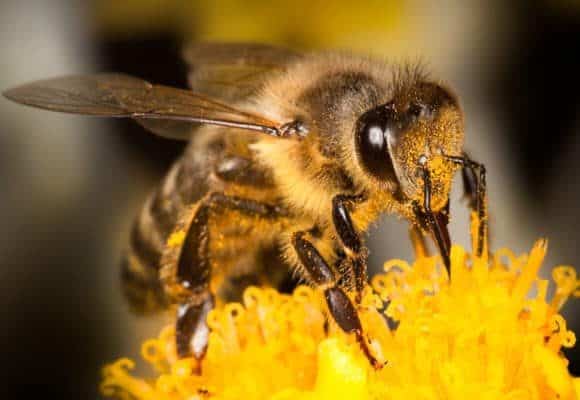
Honey bees have black and yellow bands and their wings have a translucent look to them.
Summary Of Honey Bee, Carpenter Bee, And Bumblebee Appearance
| Size | Color | Shape | Body Hair | |
| Honey Bee | ± 1/2 inch | Black & yellow Bands | Slender with pointed abdomen | Medium amount of hair throughout body |
| Carpenter Bee | 1/2 – 1 inch | Yellow thorax, mostly black, green, or purple | Robust and rounded | Hair on thorax, no hair on abdomen |
| Bumble Bee | 1/4 – 1 inch | Black and yellow bands | Robust and rounded | Fuzzy throughout the body |
Nesting Habits Of Bumblebees, Honey Bees And Carpenter Bees
Even though they are relatives, each of these species has distinct habits when it comes to making a nest as well as individual social habits and behavior.
Both honey bees and bumblebees live in colonies and make hives, while carpenter bees are solitary and do not build hives in a colony.
Nesting Habits Of A Carpenter Bee
Instead of building a hive, the carpenter bees will burrow into wood, hence the inspiration for the name.
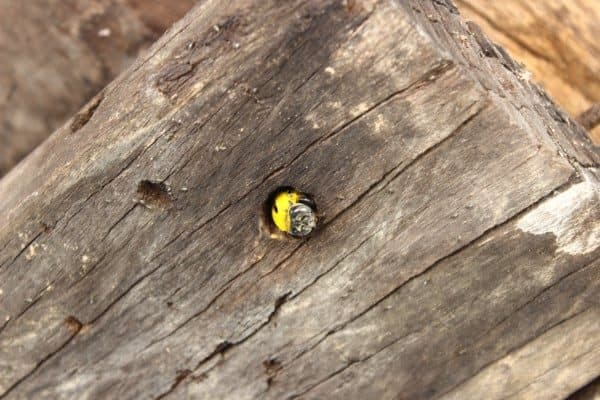
These solitary bees spend most of their lives alone. During winter the adult carpenter bees hibernate in separate burrows which are usually previously constructed brood tunnels. If they survive the winter, they emerge when the weather warms up and seek a new mate.
Nesting Habits Of Bumblebees
Bumblebees do not like to nest in areas that are exposed to long periods of sun as it may make the nest too warm.
Some species of bumblebee nest underground in places such as under sheds, in compost heaps, or inside abandoned rodent holes. Other species create their homes above ground in long grass.
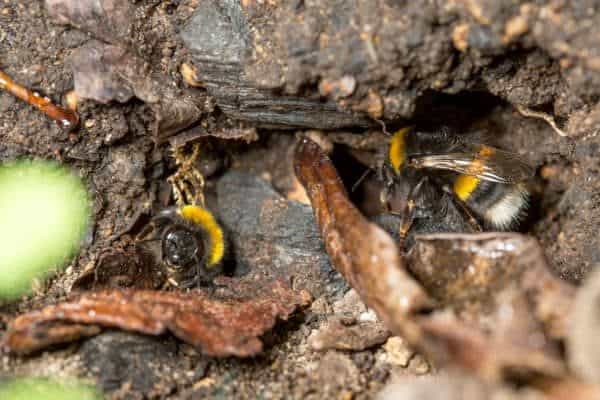
It is also common to find bumblebees nested in trees, bird boxes, or in a loft. This subspecies is known as the “Tree Bumblebee.”
Although just like honey bees, bumblebees are social insects, building hives and wintering together, their colony population is much smaller. A healthy bumblebee colony usually only comprises approximately 400 bees.
There is one queen bee per bumblebee colony. The male bees mate with the queen, while the workers (females) explore the world, build the nest, and gather resources.
Unlike honey bees, who maintain the colony throughout winter, bumblebee colonies die out in the winter months. The final brood will be full of females who will mate and become queens.
Each queen will go off on her own to find a spot to hibernate for the cold months.
If you are interested we have an entire article dedicated to the nesting habits of bumblebees. The article is called, Do Bumblebees Live Alone or in Colonies?
Nesting Habits Of Honey Bees
Honey bees are extremely social. Their colony includes a single queen, male drones who mate with the queen, and female worker bees.
Wild honey bees often make their hives in the holes of trees, where the worker bees create wax structures from their abdominal glands.
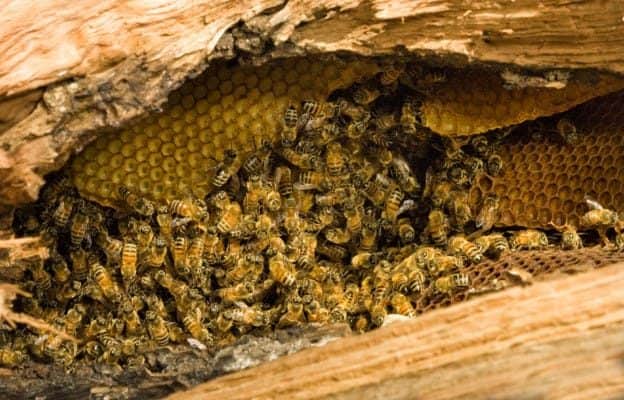
Honey bee colonies are much larger than that of bumblebees and can range from 10,000 to 80,000 bees, depending on food availability, location, and the time of the year.
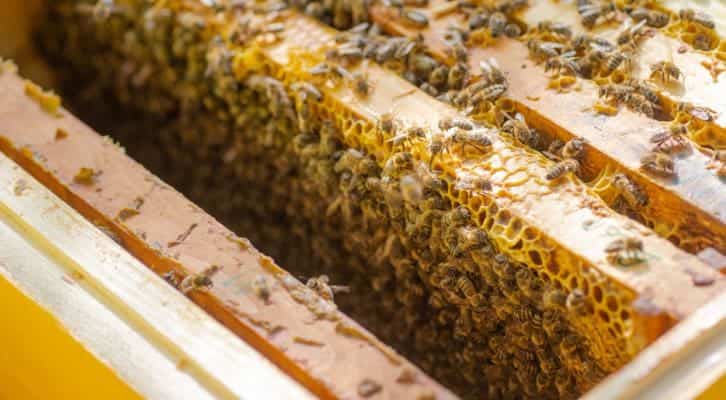
Honey bees winter during cold months. The male bees, called drones, are kicked out of the hive as they provide no benefit to the hive during winter. Brood production will practically cease. Worker bees will cluster together around the queen bee to keep warm if they are located in a region with cold winters. The hive will feed on stored honey to survive until the warmer spring weather arrives.
We have an article specifically on how honey bees are able to survive the winter. If you are interested in checking it out it is called, How Do Bees Survive The Winter?
Summary Of a Honey Bee, Carpenter Bee, And Bumblebee Nesting Habits
| Nest Location | Colony Size | Colony Distribution | Winter Habits | |
| Carpenter Bee | Burrows and tunnels inside of wood. | Individual species (no colony). | N/A | Adults winter individually. |
| Bumblebee | Underground, on the ground, in trees or lofts. | Up to 400 | Single queen, few males, and many females. | Only the queens survive through winter. |
| Honey Bee | In boxes or tree holes. | 10.000 – 80,000 | Single queen, a few hundred males, and thousands of females. | Male drones locked out of the hive. Queen and workers survive until spring. |
Reproduction And Life Cycle Of Carpenter Bees, Bumblebees And Honey Bees
Whether we look at the life cycle of a carpenter bee, bumblebee, or honey bee, there are always four distinguishable stages of life: The Egg, the larva, pupa, and the adult stage.
All three species lay their brood during warmer months. This process begins at the start of spring, which is usually considered to be the beginning of the bees’ life cycle, and stopped before the bees start to winter.
The Life Cycle Of Carpenter Bees
Carpenter bees live a fairly short life. The females tend to survive approximately 1 year, or slightly over. Males will live a single year as they die straight after mating with the female.
Taking a closer look at the four stages involved with the carpenter bee life cycle we can assess the similarities and differences from that of the honey and bumblebee.
Carpenter Bee Egg Stage
Before laying her eggs, the female carpenter bee needs to construct a nest. She does this by burrowing into a wooden object. Using her mandibles, the female “chews” her way 2 inches into the wood before making a 90-degree turn and continuing to burrow parallel to the outside of the wood for approximately 4 – 6 inches.
Here the female will lay between 6 – 10 eggs in individual brood cells. The eggs will spend approximately 2 days before hatching into a larva.
Carpenter Bee Larva Stage
Once the egg hatches the larvae emerge and live within the brood cell, safely deep inside of the nest tunnel.
The larva feeds on a mixture of pollen and regurgitated nectar that the female carpenter bee stored within the brood cell. This mixture is known as bee bread.
The insect spends approximately 15 days as a larva.
Carpenter Bee Pupa Stage
The pupa stage lasts for around 15 – 20 days, depending on the subspecies. During this stage metamorphosis takes place. It is at this stage that the larva begins to turn into a fully grown adult.
While this is a very vulnerable time for the bee, it is safer than most insects as it remains in the brood cell, protected by the tunneled nest.
Carpenter Bee Adult Stage
Approximately 7 weeks after being laid as an egg, the adult carpenter bee will break free of the brood cell and begin its adult life.
Both the females and males will leave the nest in search of a mate. Once the males have mated they die. If a male is unsuccessful in finding a mate, it dies as soon as winter comes.
Female carpenter bees will either find a new suitable nest or return to their original nest. The female carpenter dies after laying her eggs.
The full life cycle of a carpenter bee is approximately 1 year, depending on weather conditions, food availability, mating, and predators.
The Life Cycle Of A Bumblebee
Bumblebee hives have a yearly cycle. All the drones (males), and workers (females) die during the wintertime, leaving only the fertilized queens to lay eggs for the winter and restart the process in spring.
The bumblebee lifespan varies between casts. Male bumblebees live approximately 2 weeks, females live between 2 – 6 weeks, and a queen lives a full year.
Because the colony completely dies out over winter, the easiest way to look at a bumblebee life cycle is in four stages.
Stage One Of A Bumblebee Life Cycle
Queens that mated in the late summer emerge from hibernation. Unlike honey bees, the bumblebee queens do not feed during winter, they instead sleep to conserve energy.
Once fed, and the weather gets warmer, the queen lays her eggs and starts a new colony.
The queen lays a batch of 4 – 16 eggs that she fertilizes to grow female bees. During the egg stage, the queen sits on the eggs to keep them warm, similar to birds.
The eggs hatch after about 4 days. It takes approximately 4 -5 weeks from egg to adult bumblebee. Half of this time is spent as a larva and the other half as a metamorphosing pupa.
Stage Two Of A Bumblebee Life Cycle
Female worker bees emerge from the nest and begin to forage. This is the time when the nest grows the most.
During spring months the worker bees will build the hive, tend to the larva, and feed the drones.
Just like honey bees, the younger worker bees spend a few days to the first week inside of the hive, tending to household duties which include cleaning the hive, feeding the young, and tending to the queen.
Stage Three Of A Bumblebee Life Cycle
The queen bee will only begin to lay unfertilized eggs (males) towards the end of a colony’s life (as winter approaches).
During this time the queen will not lay any more fertilized eggs, therefore the sign of male bumblebees is an indication that the colony’s life is coming to an end.
When she begins laying male eggs, the queen loses some of her dominance in the hive due to a loss of certain hormones. This leads to some of the worker bees developing ovaries and laying unfertilized eggs of their own.
During the latter part of this stage, the last batch of fertilized eggs will develop into new queens. Although worker bees can lay male eggs, they are not able to lay fertilized eggs.
Stage Four Of A Bumblebee Life Cycle
In the final stage of the colony’s life, the males leave the hive in search of newly established queens to mate with.
The males die shortly after mating, while the queen will continue to forage and fatten up in preparation for winter.
The female will find a suitable spot to hibernate, which is usually underground. This hibernation can last between 6 – 9 months, depending on the species and the spring temperature.
The Life Cycle Of A Honey Bee
Unlike bumblebees, a honey bee colony survives throughout the winter, and many winters to come, providing it is healthy and has stored enough resources during the spring and summer.
Female bees live between 2 – 45 weeks, depending on activity levels. Males live for 3 – 12 weeks, depending on the time of year they were born, and queens have been known to live up to 7 years.
The honey bees go through all four stages from egg to adult, although this time is different from that of the carpenter bee and bumblebee.
These stages also differ depending on the cast of the bee (worker, drone, or queen).
The Honey Bee Drone
The complete metamorphosis from egg to adult for a drone bee is approximately 24 days. Drones have only one purpose, and that is to mate with a virgin queen. After 6 – 12 days, the drone will leave the hive in search of a queen.
The male drones die shortly after mating and only return to the hive if they are unsuccessful.
Because they have no purpose in the hive, when winter comes, the males are forced out of the hive and usually freeze to death or die of starvation.
The Worker Honey Bee
Taking approximately 21 days from egg to adult, the female bees are put to work straight away.
Just like the bumblebee workers, they remain in the hive for 1 – 3 weeks tending to tasks.
Worker bees spend their lives foraging for nectar, making honey stores for winter, and caring for the larva.
The lifespan of a worker bee tends to be shorter during spring and summer because of their high level of activity. If an unfertilized female is laid before winter, they live for longer as the activity in the hive is low during colder months.
The Queen Honey Bee
By far outliving the workers and the drones, queens are the cornerstone of a colony and will live for several years.
It takes approximately 16 days for a queen to develop from an egg into an adult. This is largely because of the highly nutritious royal jelly that the larvae are fed.
The two biggest factors that affect the life of a queen are winter stores and her productivity.
If a hive does not have enough food for winter and the queen dies, the colony will likely die.
Alternatively, if a queen begins to lay too many males (unfertilized eggs) then the workers will begin to raise a new queen and abandon the old queen.
Summary Of Carpenter Bee, Bumblebee, And Worker Bee Life Cycles
| Female | Male | Queens | Colony Survives Winter | |
| Carpenter Bee | 1 + years | 1 year | No queen bee | Solitary. No colony |
| Bumblebee | 2 – 6 weeks | 2 weeks | 1 year | Colony dies after summer |
| Honey Bee | 2 – 45 weeks | 3 – 12 weeks | 2 – 7 years | Colony survives multiple winters |
Abilities To Pollinate
Bees are responsible for up to 80% of crop pollination and a vital part of biodiversity among the floral kingdom. All three species play a massive role in pollination.
Below is a short list of some of the flowers, fruits, and vegetables that are included in this process. Note that this is just an example list and is not limited to only these plants.
| Common Plant Name | Carpenter Bee (Solitary Bees) | Bumble Bee | Honey Bee |
| Orka | √ | X | √ |
| Kiwifruit | √ | √ | √ |
| Potato | √ | √ | X |
| Onion | √ | X | √ |
| Strawberry Tree | X | √ | √ |
| Broccoli | √ | X | √ |
| Cabbage | √ | X | √ |
| Papaya | X | X | √ |
| Coffee | √ | X | √ |
| Cauliflower | √ | X | √ |
| Cucumber | √ | √ | √ |
| Carrot | √ | X | √ |
| Sunflower | √ | √ | √ |
| Lime | X | X | √ |
| Orange | X | √ | √ |
| Jack Bean | √ | X | X |
| Prickly Pear | √ | √ | X |
It is important to remember that this is only a list with a few samples, as thousands of flowers and edible food species are pollinated by bees each year.
The Pros And Cons Of Having Carpenter Bees, Bumblebees And Honey Bees In Your Garden
All three of these bees are great pollinators and will bring life to your garden, but their usefulness does not stop there.
And yes, with everything good that comes to your garden there are also a few downsides.
Let’s take a quick look at the pros and cons of having carpenter bees, bumblebees, and honey bees in your garden and around your house.
Pros And Cons Of Carpenter Bees
The Pros
- Carpenter bees are amazing pollinators.
- Carpenter bees are not aggressive, and therefore it is highly unlikely to be stung by them.
- They expand the biodiversity of your garden by attracting natural predators such as woodpeckers, shrikes, honey badgers, and mantises.
The Cons
- Carpenter bees may choose to burrow into the wood of your house instead of a tree.
- Even though they make shallow holes, the attraction of woodpeckers and rodents may cause further structural damage.
- Although rare, a sting from a carpenter bee can bring on allergies, and in some cases, serious medical problems.
The Pros And Cons Of Bumblebees
The Pros
- Bumblebees are amazing pollinators.
- Bumblebees are not aggressive.
- Only the females can sting.
- Bumblebees can and do pollinate in bad weather.
- Predators such as birds and spiders are attracted to your garden, bringing their own benefits.
The Cons
- Bumblebees are known to attack other bee species as well as sting the queen from nearby bumblebee colonies.
- Some people may face allergic reactions to the sting of a bumblebee.
- Bumblebees can sting multiple times, in the same way as a hornet or a wasp.
The Pros And Cons Of Honey Bees
The Pros
- Honey bees are amazing pollinators.
- Honey can be harvested from wild or man-made hives.
- The by-products such as beeswax and propolis are useful to humans.
- Each bee can only sting once.
The Cons
- Honey bees are more aggressive and will sting when they feel threatened.
- The sting of a honey bee is barbed and can remain inside the skin.
- Honey bee stings can cause allergic reactions and hospitalization for some.
- Honey bees may compete with native bees, although this is not often the case.
Bees are incredibly fascinating creatures. Whether you look at carpenter bees, bumblebees, or honey bees, they all bring an advantage to your garden and the environment around you.
The Wrap Up
Although they are all from the bee family, they are quite different from each other in shape, size, and behavior.
Perhaps one of the biggest differences between the three species is the way that they nest and create hives.
That being said, it is extremely useful having these pollinating machines around your garden.
